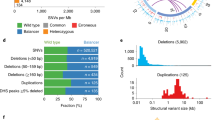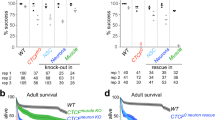Abstract
Chromosome breaks throughout a 70-kilobase (kb) region of the Drosophila bithorax complex (BX-C) result in the homoeotic Ultrabithorax (Ubx) mutations1. These cause the third thoracic and first abdominal segments of the Drosophila embryo to develop structures normally characteristic of the first and second thoracic segments2–6. We show here by genetic mapping that apparent point mutations with Ubx phenotypes are located at both ends of this 70-kb region. Mutations located at either end of the Ubx unit have indistinguishable phenotypes, suggesting that both classes inactivate most or all wild-type, Ubx+, functions. This observation supports the suggestion1 that Ubx mutations directly inactivate a product encoded by 5′ and 3′ exons of a long transcription unit.
This is a preview of subscription content, access via your institution
Access options
Subscribe to this journal
Receive 51 print issues and online access
$199.00 per year
only $3.90 per issue
Buy this article
- Purchase on Springer Link
- Instant access to full article PDF
Prices may be subject to local taxes which are calculated during checkout
Similar content being viewed by others
References
Bender, W. et al. Science 221, 23–39 (1983).
Lewis, E. B. Cold Spring Harb. Symp. quant. Biol. 16, 159–174 (1951).
Lewis, E. B. Am. Zool. 3, 33–56 (1963).
Lewis, E. B. Nature 276, 565–570 (1978).
Morata, G. & Kerridge, S. Nature 290, 778–781 (1981).
Struhl, G. Nature 308, 454–457 (1984).
Lewis, E. B. in Heritage from Mendel (ed. Brink, R. A.) 17–47 (University of Wisconsin Press, Madison, 1967).
Lewis, E. B. ICN–UCLA Symp. molec. cell. Biol. 23, 189–208 (1981).
Morata, G. & Kerridge, S. in Development and Neurobiology of Drosophila (eds Siddiqi, O., Babu, P., Hall, C. & Hall, J.) 141–154 (Plenum, New York, 1980).
Kerridge, S. & Morata, G. J. Embryol. exp. Morph. 68, 211–234 (1982).
Akam, M. E. Trends biochem. Sci. 8, 173–177 (1983).
Akam, M. E. EMBO J. 2, 2075–2085 (1983).
North, G. Nature 303, 134–135 (1983).
Lindsley, D. L. & Grell, E. H. Genetic Variations of Drosophila melanogaster (Carnegie Instn Washington Publ. No. 627, 1968).
Author information
Authors and Affiliations
Rights and permissions
About this article
Cite this article
Akam, M., Moore, H. & Cox, A. Ultrabithorax mutations map to distant sites within the bithorax complex of Drosophila. Nature 309, 635–637 (1984). https://doi.org/10.1038/309635a0
Received:
Accepted:
Issue Date:
DOI: https://doi.org/10.1038/309635a0
This article is cited by
-
Three euchromatic DNA sequences under-replicated in polytene chromosomes of Drosophila are localized in constrictions and ectopic fibers
Chromosoma (1987)
-
Clonal analysis of two mutations in the large subunit of RNA polymerase II of Drosophila
Molecular and General Genetics MGG (1985)
Comments
By submitting a comment you agree to abide by our Terms and Community Guidelines. If you find something abusive or that does not comply with our terms or guidelines please flag it as inappropriate.



